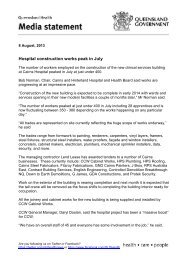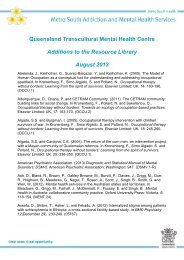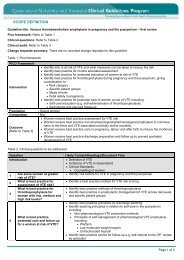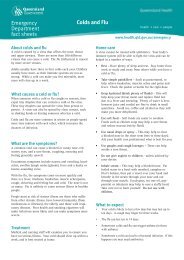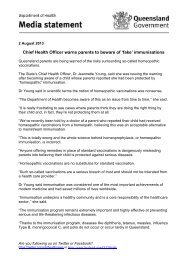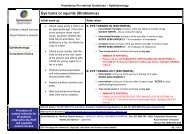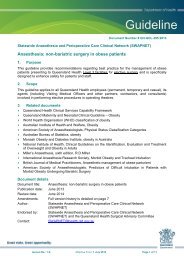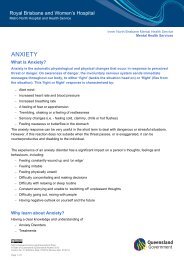Paediatrics - Queensland Health - Queensland Government
Paediatrics - Queensland Health - Queensland Government
Paediatrics - Queensland Health - Queensland Government
Create successful ePaper yourself
Turn your PDF publications into a flip-book with our unique Google optimized e-Paper software.
Ear problems<br />
Ear discharge in the presence of grommets<br />
1. May present with<br />
• History of insertion of grommet in one or both ears<br />
• Discharge of pus from a grommet, fever, URTI, related to water immersion<br />
2. Immediate management Not applicable<br />
3. Clinical assessment<br />
• Obtain a complete patient history. See Assessment of the ear<br />
• Perform standard clinical observations<br />
• Perform physical examination. See Assessment of the ear plus:<br />
-- clean the ear using tissue spears until all pus has been removed and the<br />
drum and perforation can be seen<br />
-- document the size and position of perforation on a diagram in the case notes<br />
4. Management<br />
• Consult MO for antibiotic order<br />
• Treat as per Acute otitis media with perforation<br />
5. Follow up<br />
As per MO instructions<br />
Advise no swimming. If this is not possible in a hot tropical climate, ear plugs with<br />
a swimming cap for swimming are recommended for children with grommets.<br />
Effective ear plugs can be custom built or made from silicon putty, cotton wool<br />
with Vaseline, or “Blu-Tack®”<br />
6. Referral / consultation<br />
As above<br />
Cholesteatoma<br />
Recommend<br />
Be aware of cholesteatoma when performing all otoscopic examinations<br />
Cholesteatoma is treated surgically and success is highly dependent on early<br />
recognition and the extent of the lesion<br />
Background<br />
Most patients who acquire cholesteatomas have a history of recurrent acute otitis<br />
media and / or chronic middle-ear perforation<br />
Patients with a family history of chronic middle ear disease and / or cholesteatoma<br />
are at increased risk [9]<br />
Related topics<br />
Acute otitis media with perforation Assessment of the ear<br />
1. May present with<br />
If diagnosed early may have no symptoms. Otherwise may present with:<br />
• Dizziness, ache behind the ear especially at night<br />
• Muscle weakness of the face, foul odour from the ear<br />
• White mass behind intact ear drum on otoscopic examination<br />
• New onset of hearing loss in a previously operated ear<br />
• History of chronic perforation of the ear drum<br />
Primary Clinical Care Manual 2011 Controlled copy V 1.0 595



